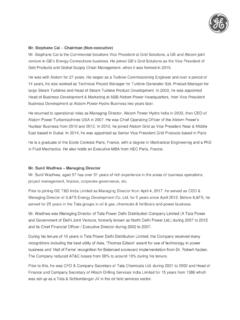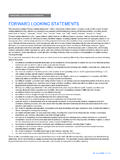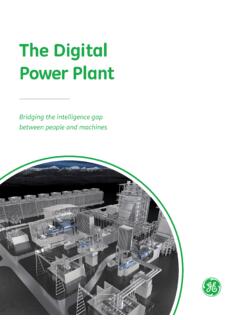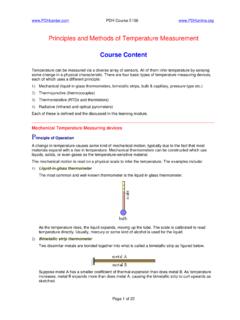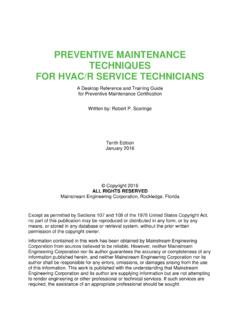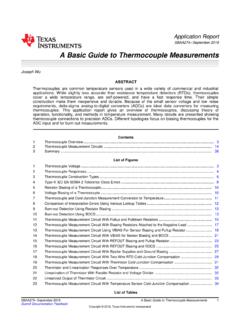Transcription of Generator In-Situ Inspections - General Electric
1 GE Energy Generator In-Situ Inspections A Critical Part of Generator Maintenance Cost Reduction GER-3954C. Authors Christopher Markman Product Line Leader Life Extension Services Ronald J Zawoysky Generator Engineering Leader Power Generation Services Contents Introduction .. 1. In-Situ Inspection A Critical Part of Generator Maintenance Cost Reduction .. 2. Guidelines for Choosing In-Situ Inspection Versus Pulling the Rotor .. 3. In-Situ Inspection Technologies .. 3. Miniature Air Gap Inspection Crawler (MAGIC) .. 6. Remote Capacitance Probe .. 8. Retaining Ring NDE Scanner .. 8. Other Testing .. 9. MAGIC Acceptance and Experience .. 9. Industry Acceptance .. 9. System Design .. 9. Traditional vs. In-Situ Cost Analysis .. 9. Reducing Outage Duration .. 10. Reducing Disassembly Requirements .. 10. Eliminating Consequential Damage .. 10. GE's Position on In-Situ Inspection .. 11. Conclusions .. 11. List of Figures .. 12. List of Tables .. 12. GE Energy | GER-3954C (3/12) i Introduction Updating equipment maintenance recommendations based on GE's fleet experience This paper compares In-Situ inspection techniques that allow testing with the rotor still installed, to rotor-out Inspections .
2 While In-Situ Developing inspection tools and services that facilitate rapid Inspections provide an alternative to pulling the Generator rotor, offline assessment of equipment conditions additional electrical testing is required, at a minimum, to provide a thorough inspection. Other additional tests may be indicated via a Industry insurers also have a vested interest in these objectives and Technical Information Letter (TIL) or based on past unit history. are understandably reluctant to assume greater risks by deviating from proven maintenance practices. Consequently, insurers review As the increasingly competitive marketplace forces the power proposed plant maintenance protocol modifications with operators generation industry to reduce operating costs, equipment and often require supporting recommendations and other evidence maintenance programs are under increased fiscal scrutiny. Plant from Original Equipment Manufacturers (OEMs) that new protocols maintenance programs, based on periodic disassembly and are functionally equivalent or superior to the traditional.
3 Inspection of critical turbine- Generator components, have proven remarkably effective as evidenced by the industry's consistently This paper offers a comparison of the results, advantages and favorable plant reliability and availability statistics. However, limitations of GE's modified inspection protocol for generators many plant operators are looking for ways to lower cost while utilizing In-Situ inspection tools compared to a traditional inspection maintaining reliability. with the rotor removed. As a leading manufacturer of turbine-generators and a major supplier of power generation services, GE is assisting operators in this objective by: Developing improved monitoring and diagnostic instrumentation for online predictive maintenance, allowing for better outage planning and scope control GE Energy | GER-3954C (3/12) 1. In-Situ Inspection A Critical Part of Generator During minor outages, In-Situ Inspections can be used to assess Maintenance Cost Reduction Generator condition and help plan Generator maintenance at future outages.
4 The inspection results can indicate if the field will Visual and quantitative inspection techniques play an important need to be pulled and which components will require maintenance role in assessing Generator condition. Online monitoring and during current or future outages. If the Generator condition is diagnostic techniques are limited in detecting potential problems acceptable, the field can remain in place and a future In-Situ such as bar movement and vibration, component damage, copper inspection can be planned. GE's In-Situ inspection techniques can dusting, coil distortion, and foreign object damage (FOD). Since also be used with traditional inspection and test techniques to many of these conditions can lead to a major equipment failure if provide a complete major inspection without field removal. left unresolved for a period of time, periodic visual Inspections are needed to supplement online monitoring and diagnostics. In-Situ inspection offers an economical alternative to the traditional rotor GE's recommended standard tests for a major outage are described pull inspection.
5 Table 1 lists typical Generator -related Inspections in Technical Information Letter-1154 and GEK-103566. When and when they occur in a traditional maintenance plan. Generator problems are known or suspected to exist, applying Continuous Online Periodic Online Minor Outage Major Outage STATOR. Stator Wedge Tightness X. Bar Movement X. Stator Winding Leaks SLMS X X. Core Insulation X. Stator Winding Insulation Integrity ePDA PD X X. Greasing X. Cracked Connections/Integrity X X. Oil Contamination X X. HV Connection Bolts X X. FIELD. Blocked Vent Ducts X. RR NDT X. Field Coil Distortion X X. Field Coil Loose Blocks X X. Field Wedge Migration X. Field Winding Insulation Integrity STMS X X X. Thermal Sensitivity X. Rotor Surface Heating X. Table 1. Generator inspection items STMS: Shorted Turn Monitoring System continuously monitors a flux probe and sends an alarm when a shorted turn is detected ePDA: Enhanced Partial Discharge Analysis continuously monitors the Generator and takes partial discharge data at specified intervals for later analysis PD: Traditional Partial Discharge Testing where data is taken by a technician SLMS: Stator Leakage Monitoring System continuously monitors stator cooling water for the presence of hydrogen indicating a leak GE Energy | GER-3954C (3/12) 2.
6 Periodic In-Situ Inspections can postpose the need for field removal until a more convenient time. When abnormal operation such In-Situ Inspection Technologies as a negative sequence event warrants a suitability for service GE's In-Situ Generator inspection capabilities (listed below) were inspection before the Generator can be returned to service, the developed to address areas requiring field removal for inspection In-Situ inspection is a valuable tool for providing a quick, accurate, (Figure 1). documented inspection with minimal Generator disassembly. In-Situ GE's proprietary Miniature Air Gap Inspection Crawler (MAGIC) system inspection reduces overall outage duration while gathering high- quality condition assessment data. MAGIC Visual Inspection Stator Wedge Tightness Assessment Guidelines for Choosing In-Situ Inspection Electromagnetic Core Imperfection Detection (EL CID). Versus Pulling the Rotor Borescope Inspection One question frequently asked is What if the In-Situ inspection finds something and I have to pull my field?
7 I wasted time and Remote Capacitance Probe money on the In-Situ inspection. The answer to this question can Retaining Ring Non-Destructive Evaluation (NDE) Scanner be found in previous inspection reports and the operating history of the unit. If there is any indication that the rotor needs significant Other tests and Inspections , including electrical testing and repair (such as multiple shorted turns, a field ground or thermal hydraulic testing sensitivity), then the rotor should be pulled. Similar judgements should be made regarding the stator. However, if the unit has had The In-Situ inspection consists of the basic MAGIC visual inspection no known problems and previous Inspections have not indicated as well as one or more additional tests or Inspections based on the any issues, then an In-Situ inspection is appropriate. GE experience circumstances and customer needs. Table 2 lists critical Generator reveals that 1 percent of In-Situ Inspections uncover an issue which components and the In-Situ inspection techniques used for each.
8 Requires that the rotor to be pulled. In many cases, conditions requiring repair are found early enough to allow the repair to be Note: While a borescope inspection is a normal part of a MAGIC. postponed until the next planned outage. Conditions found by inspection, it may also be performed independently. This is typically In-Situ Inspections that required the rotor to be pulled for repairs done when a fast assessment of the Generator , especially the end include foreign object damage, damage from negative sequence regions, is desired after an event outside of normal operation. events, failure of electrical testing indicating the need for rotor rewind, and loose wedges. These conditions are listed in order of highest to least prevalence. Since GE's goal is to ensure the Generator runs trouble-free to the next outage, any significant problem will bring a recommendation to pull the rotor and complete the necessary repairs. For maximum benefit, the In-Situ inspection should be planned as early as possible during the outage so that any necessary repairs can be carried out during the planned outage, or at worst, the inspection will cause the minimum delay to restart.
9 GE Energy | GER-3954C (3/12) 3. Stator Wedge Tightness Assessment MAGIC Visual Electromagnetic Core Imperfection Core Laminations Detection (ELCID). Space Blocks Stator Insulation Capacitance Stator Bars, Wedges Measurement Field Surface, Wedges Retaining Ring Nose Stator Clearance Measurement Remote Access Cameras Retaining Rings Field Coil End turns Outside Surface Connection Rings Eddy Current Stator Bars Inner Surface End Winding support System Ultrasonic Flux Shield Lower Frame Extension Figure 1. Generator In-Situ inspection capabilities GE Energy | GER-3954C (3/12) 4. Borescope Wedge Clearance Component Common Problems MAGIC Visual ELCID RR NDE Capacitance Visual Tapping Meas. Stator/Core Core Laminations Foreign object damage, hot spots, evidence of X X. movement Space Blocks Migration, cooling passage X X. blockage Gas Gap Baffle Studs Cracked welds, looseness X X. Stator Wedges Looseness, loss, sparking X X. damage Stator Bars Foreign object damage, sparking, girth cracks, X X X.
10 Movement Wet groundwall insulation X. End Windings and Bar movement, loose/broken Connection Rings ties, supports, etc., excessive X. corona activity Copper Flux Shield Overheating, looseness, X. General condition Instrumentation RTD, thermocouple wiring ties, flux probe, General X. condition Field Field Surface Heating, arcing, foreign X. object damage Body Weights Looseness, staking X. Field Wedges Arcing, migration, cracking X X. Retaining Ring Wedge contact, arcing, foreign object damage, X X X. material cracks, pitting Coil End Turns Blocked ventilation, damaged insulation, coil X. distortion, contamination General All Excessive oil or other contamination, foreign X X. object damage, blocked cooling Lower Frame Ext. Insulation condition, Bus Leads and connection integrity (if X. Connections exposed), high voltage bushing condition Table 2. In-Situ Inspection capabilities GE Energy | GER-3954C (3/12) 5. Miniature Air Gap Inspection Crawler (MAGIC) Stator Wedge Tightness Assessment This test examines the slot support system for any signs that the stator bars are free The cornerstone of the MAGIC system is its visual inspection to move.



